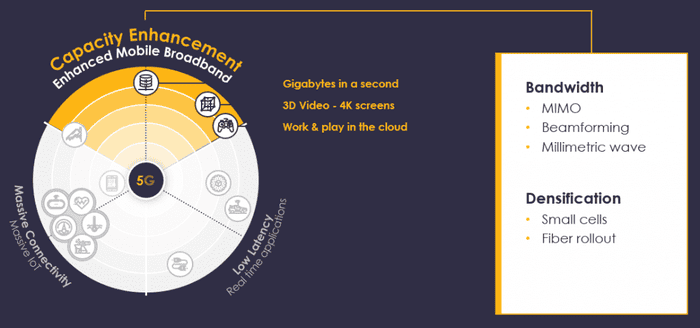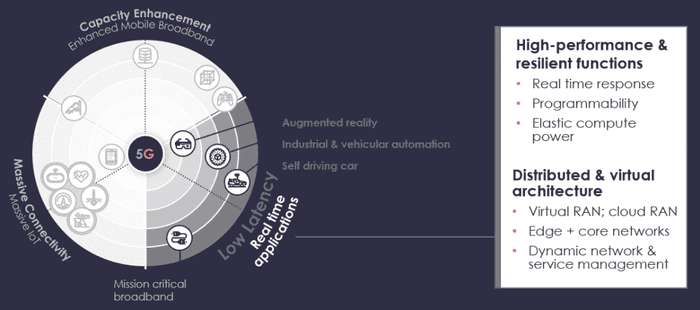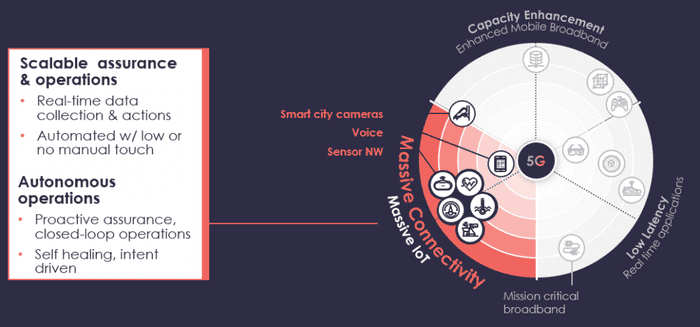Open 5G: Fast. Smart. MonetizeOpen 5G: Fast. Smart. Monetize
March 1, 2019

The open imperative
Open, intelligent networks will form the foundation for tomorrow’s digital society. They will leverage the speed of 5G and high-performance infrastructure to drive hyper-scale transactions and immersive experiences. Edge and cloud connectivity will bring to life rich enterprise services, on demand and scaled for purpose. Open networks leverage the strength of open-source and open standards, are virtualized running on cloud technologies, and infused with AI for automation and security.
Amdocs’ Open 5G solutions suite is designed to help service providers accelerate their 5G journey to the new era of virtualized, distributed cloud networks and intelligent connectivity. Open 5G is part of the Amdocs Open Network portfolio, which gives service providers the freedom to work with a wide range of innovation partners and across multiple environments and domains. This means more choice, faster service delivery, better customer experiences and accelerated revenue growth.
Meeting the demands of the 5G Era
As service providers deploy 5G networks and enhance LTE infrastructures along the way, they are looking to meet connectivity demands at a lower per-unit cost to stay competitive, want flexibility and agility to implement the best-match technology, and are seeking to improve efficiencies despite operating in an increasingly complex environment – while at the same time delivering an exceptional end-user experience, and accelerating new revenue streams in enterprise and via differentiated consumer services.
5G means different things to different people, but in general 5G leaps past existing 4G/LTE networks in three areas: capacity/throughput enhancement; low latency, and massive connectivity. Each area poses a different set of requirements for the network and creates different fulfillment challenges. But, in a nutshell, the following are the key changes in the network needed to address these three goals:
New radio and network densification, including small cells rollout and fiber deployment.
Hybrid networks, covering the full mix of fixed plus mobile (FMC), physical plus virtual (NFV/SDN), 4G plus 5G (C-RAN, MEC, UP-CP separation), and cloud plus edge.
Distributed core networks, mesh connectivity and slicing, coupled with dynamic network and service management.
Proactive assurance, automation and closed-loop operations.
Everything underpinned with an open, multi-vendor ecosystem of solutions.
To achieve their objectives, service providers need a strong, capable partner and enabler to drive the required network transformation. Amdocs’ vast experience, comprehensive solutions portfolio and disruption position in the network space can all help service providers best realize fast, open, smart and monetized networks.
Amdocs Open 5G
Amdocs Open 5G is based on open APIs and open-source software such as the Linux Foundation’s Open Networking Automation Platform (ONAP), and integrates with partner technologies, all to create an open and comprehensive ecosystem of capabilities. Open 5G includes solutions in three areas that enable service providers to accelerate and simplify their 5G and future network journeys.
Open 5G Fast focusses on getting rapidly to market with solutions for network planning and placement, densification and rollout, integration and acceptance, and end-to-end optimization.
Open 5G Smart drives automation and intelligence to the service layer with Amdocs’ network orchestration, autonomous operations, and slice and edge management solutions.
Open 5G Monetize includes Amdocs’ 3GPP-compliant charging platform designed to run at the scale and speed of 5G. Other essential elements of Amdocs’ monetization platform include rapid partner onboarding, agile catalog to create the right offers for tomorrow, and digital user engagement.
Open 5G – Fast
The nature of 5G technology is such that achieving the required capacity and performance involves utilizing wider spectrum and higher frequencies (MM wave), which in turn involves placing many more components into the network, covering the radio, backhaul and core network. This is achieved through network densification. Service providers are carefully looking to ensure existing asset utilization for a smooth and cost-effective transition. They are also exploring ways to increase the agility in deploying network infrastructure (more radio sites, more fiber, shared spectrum, etc.) and application capabilities required to meet their needs.
Business-as-usual approaches for network planning, build out and acceptance to achieve densification and ‘turn up’ of new/shared spectrum are neither scalable nor efficient. Furthermore, the lead times for operationalization and launch will be unacceptable by the business. Service providers need different approaches that leverage automation, and experts to drive faster and more efficient deployments.
Fig 1. – Capacity Enhancement: Network Requirements

To support network densification, Amdocs has several relevant solutions and services that can increase service provider agility in deploying new infrastructure, and rapidly expand and optimize the network to deliver the services customers expect. We can simplify and streamline 5G network rollout with vendor-independent, standardized best practices for network planning, network optimization, network integration and network acceptance. Amdocs can perform these activities 30-40% faster through use of advanced software solutions for data analysis and collection, and process automation. This includes support for advanced radio technologies such as 5G MIMO benchmarking/optimization and smart capacity planning that applies advanced algorithms to a combination of network and business data to make investment recommendations. Additionally, Amdocs supports intelligent management of spectrum, including re-farming and optimization.
In the US market, Amdocs also enables operators to rapidly and cost-effectively leverage shared spectrum through our CBRS spectrum access system (SAS) subscription offering. This FCC-certified solution fosters the development of innovative new wireless broadband services and business opportunities utilizing the newly available high-quality CBRS spectrum (3.5GHz band).
Open 5G – Smart
Low latency is critical to many of the 5G real-time applications that service providers are exploring for new revenues. Service providers are looking to have more flexibility and agility in supporting real-time applications and implementing the best-match infrastructure / technology for these applications. They are seeking solutions to enable them to move away from closed, monolithic and dedicated appliance architectures to open, modular distributed networks that are software-defined, virtualized and cloud-based. Additionally, they are seeking the software smarts to orchestrate and manage all the pieces in this distributed virtualized network, avoiding the vendor lock-in they are subject to in today’s networks.
Fig. 2 – Real-time Applications: Network Requirements

Amdocs has a range of capabilities to enable service providers to transition to an open and virtualized network, depending on the lifecycle stage they are in. For those service providers just getting started on moving forward one VNF at a time, we can provide consulting and professional services for onboarding deployment and testing. For those service providers looking to enhance services or deliver new services to market using a new parallel stack, we can provide a packaged solution (e.g. vRAN, vPCRF, etc.) that allows them to get to market quickly, and then build on further over time. And, for those engaged in a full network transformation, the Amdocs NFV powered by ONAP solution provides a comprehensive orchestration and automation platform, built on open source and partnerships, with integrated intelligence and analytics, and multiple cloud deployment options – all with the aim of helping services providers accelerate the transition to NFV/SDN and service innovation.
The increase in the number of users and devices in 5G networks, as well as network evolution, introduces a new operating environment where dynamic service and network configurations are continuously being implemented. This requires a paradigm shift in network operations from static, reactive manual operations to proactive, automated operations, with service assurance being one of the first areas needing to change. The traditional approaches for monitoring, assurance and break-fix will not work for the new network. Reactive approaches based on looking at low-level network events/telemetry and responding to them in “firefighting” mode is unsustainable. Service providers need to build a smarter network, and infuse intelligence, service-centricity and automation into all aspects of operating a complex 5G network. This need is even further accentuated as service providers are under significant pressure to reduce costs and increase automation.
Fig. 3 – Massive Connectivity: Network Requirements

The future mode of operations must be service-driven, focusing on designing how the service intent will be assured upfront, including the closed-loop models and policies to autonomously assure it. Amdocs Open5G includes an autonomous service operations capability that takes a unique approach in addressing service assurance. First, at the design stage we define the service model and the policies of how to assure it (including service intent and what telemetries to listen to). Then, after fulfillment, a state machine monitors the predefined telemetries, and understands the service impact from the modeled hierarchy. If telemetries indicate a defined policy deviation, it is autonomously resolved accordingly. In parallel, we can implement guided automation when human intervention is needed, while learning from these ongoing events to introduce updated policies for autonomous resolution. Additionally, new policies can be defined and deployed on an ongoing manner via a seamless DevOps model.
Open 5G – Monetize
The immediate push towards 5G is still centered on addressing the conventional pressures of improving customer experience and ensuring an adequate competitive response. In reality though, 5G will create a paradigm shift in monetization from volume to quality, creating many more new opportunities for service providers. New network capabilities will offer further app-based monetization opportunities and service providers will have the ability to tailor networks to partners and services in order in increase the value of those offerings.
There are different approaches to solving the monetization puzzle, and different roads that service providers will choose as they go forward. Amdocs’ capabilities, such as the network solutions previously mentioned, as well as our flexible catalog offering, optimized policy controller, charging and billing capabilities, eSIM manager, and IoT and partner platforms, all support the realization and monetization of use cases across several areas:
Slice-based connectivity: Network slicing is a mechanism that utilizes virtual slices of the network being used and sold for different scenarios based on location, usage requirements, and other parameters.
Pay-as-you-grow network infrastructure: This concept will allow service providers to tap into the “long tail” comprising a much larger number of potential users, many with smaller ARPU. Virtual environments will allow spinning up/down of resources as needed, without large upfront investments and high capex outlays, enabling service experimentation and eliminating risk of stranded capex.
5G “on the edge”: A variety of value-added services can be provided by hosting applications at the edge using mobile edge computing deployments.
Value-added services reclaimed: 5G will provide service providers with a new opportunity to position themselves as providers of additional value-add services. They could eventually evolve into platform providers for a wide range of microservices for network capabilities across core and edge networks.
Embedded communications: Logic/intelligence for things like robotics applications are generally inserted in end devices. There are opportunities to centralize the intelligence and execute actions remotely, and with 5G networks carriers can monetize these as well by putting compute functionality on a latency, high reliability network.
Ubiquitous connectivity – Fixed wireless broadband represents the shortest route to 5G monetization. Unlike most other 5G scenarios, which target mobile devices, fixed wireless is designed for static locations such as homes and businesses, potentially delivering faster speeds, while costing far less to deploy.
Enter into the new Open 5G era
Service providers have started the process of moving from monolithic network domains to modular architectures, from closed / proprietary systems to open systems with no vendor-lock-in, from static networks to more dynamic and automated networks, from siloed stacks to seamless integrated solutions that span network and IT layers, and from physical dedicated appliances to virtualized and cloud solutions
After many years of predictions and anticipation, 5G is now becoming a reality. The sheer technical scope and diversity of possible use cases encompassed by 5G means that operators will have to carefully choose their way forward. They will need solution and services partners that can truly help them transform from being traditional communications service providers to digital service providers. And most importantly, they need partners who will enable them to disrupt the existing network status quo to achieve the required flexibility, agility and speed necessary to succeed in the new market environment.
With extensive domain expertise, Amdocs can assist operators with the optimal set of solutions and services to best fit their journey, and to lead the 5G revolution. Amdocs Open 5G speeds up deployments, automates operations, streamlines innovation and opens networks to their full potential – today.
Read more about:
Vendor SpotlightsAbout the Author
You May Also Like











.png?width=300&auto=webp&quality=80&disable=upscale)


_1.jpg?width=300&auto=webp&quality=80&disable=upscale)